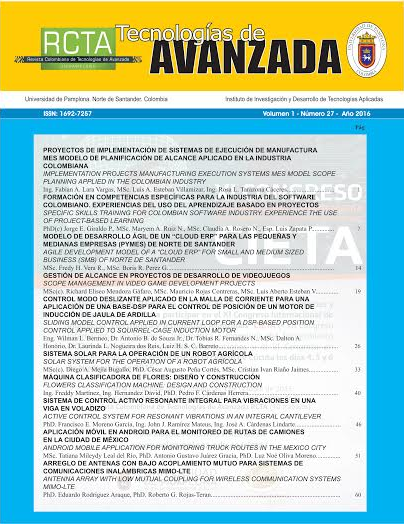Control modo deslizante aplicado en la malla de corriente para una aplicación de una base-DSP para el control de posición de un motor de inducción de jaula de ardilla
DOI:
https://doi.org/10.24054/rcta.v1i27.307Palabras clave:
Espacio Vectorial, Modo de Control Deslizante, Procesador de Señal Digital (DSP), Controlador PID, Método Modificado de Ziegler-NicholsResumen
Este articulo propone el control modo deslizante y el control por campo orientado usando referencia síncrona aplicada a un motor de inducción pequeño de jaula de ardilla utilizando modulación de largura de pulso espacio vectorial (SPWM) para el control de la posición y del torque, un procesador digital y el método de lazo cerrado con relé para evaluar los parámetros del controlador.
Descargas
Citas
Astrom, K. y Hagglund, T. (1995). “PID Controllers: Theory, Desing and Tuning”. Instrument Society of America, 2nd Edition.
Astrom, K., Lee, T. Than, K. Johansson, K. (1995). “Recent advances in relay feedback methods-a survey”. Systems, Man and Cybernetics. 'Intelligent Systems for the 21st Century’. IEEE International Conference on Volume 3, 22-25 Oct. Page(s):2616 - 2621 vol.3.
Blaschke, F. (1971) “The Principle of Field Orientation – the Basis for the Transvector Control of Three-Phase Machines”, Siemens Zeitschrift, Vol. 45, No. 10, pp. 757-760.
Bose, B.K. (1986) “Power Electronics and AC Drives”. Prentice-Hall, 1st Edition.
Casadei, D; Profumo, F; Serra, G; Tani, A. (2002) “FOC and DTC: Two Viable Schemes for Induction Motor Torque Control”. IEEE Transactions in Power Electronics, Vol. 17, No. 5.
Chan, C.C y Wang, H.Q. (1996). “New scheme of sliding-mode control for high performance induction motor drives”, IEE Proc. Electr. Power Appl. Vol. 143, Issue1, pp. 177-185.
Chung-Yuen, W., Sei-Chan, K., Bose, B. K. (1992). Robust position control of induction motor using fuzzy logic control. IAS Annual Meeting, Vol. 1, pp. 472-482.
Gamboa, P. Faria, J. Margato, E. Palma, J. Ferreira, L. (2005) “Modern Technologies for experimental education in industrial electronics and electric drives”, Power Electronics and Applications European Conference on, Dresden.
Holtz, J. (1998) “Pulse Width Modulation for Electronic Power Conversion”. IEEE invited paper.
Honório, D. A., Diniz, E. C., de Souza, A. B., Almeida, O. M., Barreto, L. H. S. C. (2010). Comparison between sliding model and vector control for a DSP-Based position control applied to squirrel-cage induction motor. IEEE/IAS International Conference on Industry Applications, pp. 1-6.
Iwasaki, M. y Matsui, N. (1993). “Robust speed control of IM with torque feedforward control”. IEEE Transactions, IE40, (6). Pp553-560.
Novotny, D.W., Lipo, T.A. (1997). “Vector Control and Dynamics of AC Drives”. Oxford Science Publications, 1st Edition.
Leonhard, W. (1990).“Trajectory control of a multi-axes robot with electrical servo drives”, IEEE Control System Magazine, Vol. 10, Issue 6, pp. 3-9.
Lin, J.L y Shiau, L.G. (1998). “PI speed control for an induction motor with inner sliding-mode torque control scheme”. Proceedings of the automatic Control Conference:: of R.O.C. pp 515-519.
Osama, M. y Abdulazim, O. (2008). “implementation and performance analysis of an elevator electric motor drive system”. 12th International Middle-East Power System Conference, Aswan.
Pessen, B.W.(1954). “How to ‘tune in’ a three mode controller”. Instrumentation. Second Quarter.
Shiau, L.G y Lin, J.L. (2001). “Staboçotu pf Sliding-mode current control for high performance induction motor position drives”. IEE Proceedings in Electronic Power Applications, Vol.148, Issue 1, pp. 69-75.
Raute, R., Caruana, C., Staines, C. S., Cilia, J., Sumner, M., Asher, G. M. (2010). Sensorless control of induction machines at low and zero speed by using PWM harmonics for Rotor-Bar slottinh detection. IEEE International Conference on Transations Electronics, Vol. 46, pp. 1989-1998.
Trzynadlowski, Andrzej M. (1982). “The Field Orientation Principle in Control of Induction Motors”. Springer Publishing, 1st Edition.
Utkin, V; Guldner, J; Shi, J. (1999). “Sliding Mode Control in Electromagnetical Systems”. Taylor and Francis, 1st Edition.
Wolovich, W.A. (1994). “Automatic Control Systems: Basic Analysis and Design”. Saunders College Publishing.
Yu, Z. (2001). “Space Vector PWM with TMS320C24x Using Hardware and Software Determined Switching Patterns”. Application Report SPRA524, Texas Instruments.
Descargas
Publicado
Versiones
- 2016-01-02 (4)
- 2016-01-02 (3)
- 2016-01-02 (2)
- 2021-01-07 (1)
Cómo citar
Número
Sección
Licencia
Derechos de autor 2016 REVISTA COLOMBIANA DE TECNOLOGIAS DE AVANZADA

Esta obra está bajo una licencia internacional Creative Commons Atribución-NoComercial 4.0.














